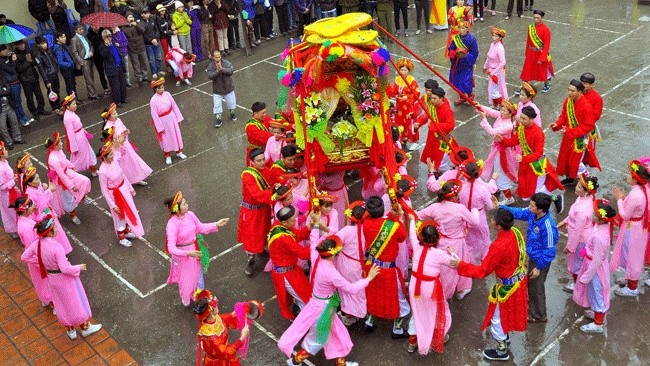Over 300 dancers and artisans gathered at the Ly Thai To flower garden near Hoan Kiem Lake to perform their special ancient dances. The dances can be divided into two main categories: spiritual and religious dances and dances used in traditional festivals imitating the activities of daily life.
The religious dances, which often feature village legends, include the chay kieu (palanquin) dance of Xuan Dinh Village; the hau dong (mediumship) dance performed by dancers from Ha Dong District; the ran lot (snake shedding) dance performed at the Linh Lang Dai Vuong God Festival in Viet Hung Ward, Long Bien district; and the cap sac (male rite of passage) ceremonial dance of Dao ethnic people in Hop Nhat Hamlet, Ba Vi Commune.
There were also four expressive dances from folk activities and festivals, namely the keo lua thoi com (rice-cooking competition) of Luong Quy Village, Dong Anh District; the mua rua (catching turtles) dance of Dao people in Hop Nhat Hamlet; the Coi Yem Mo dance of Duong Yen Village, Dong Anh District; and a gong dance featuring the unique gong culture of Muong ethnic people from Tien Xuan Commune, Thach That District.
This is the first time the festival has drawn the participation of ethnic minority artists from Hanoi since it was first organised in 2007.
According to Chairman Nguyen Van Bich of the Hanoi Dancers’ Association, the practice of 32 ancient dances of Thang Long – Hanoi has been restored since 2005, and over 20 dances have been introduced to the public during the past editions of the festival in 2007, 2008 and 2009.
Bich said that the association expected to practise and enact 35-40 repertoires for filming by 2015, in an effort to preserve and popularise the art form to international viewers. Local researchers and scholars will continue their efforts to collect and stage the dances in order to promote the cultural heritage of Thang Long – Hanoi.







![[In Pictures] Vietnamese ancient costumes restored by young people](https://image-en.nhandan.vn/350x200/Uploaded/2024/bpcgtqvp/2024_02_12/ndo-br-9-9392-8246.jpg)








